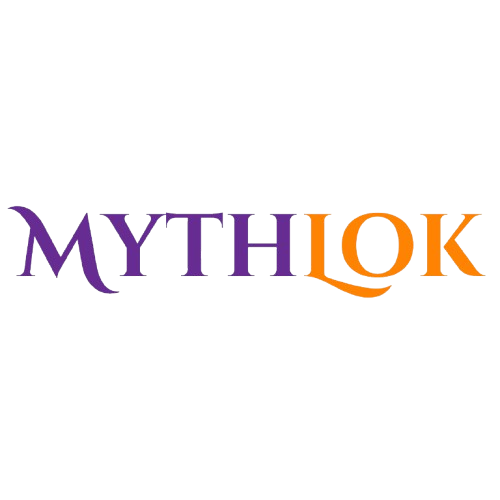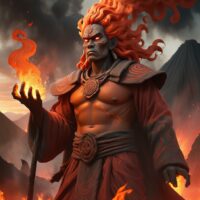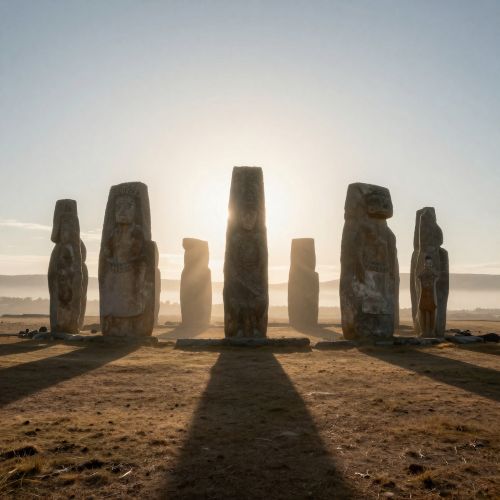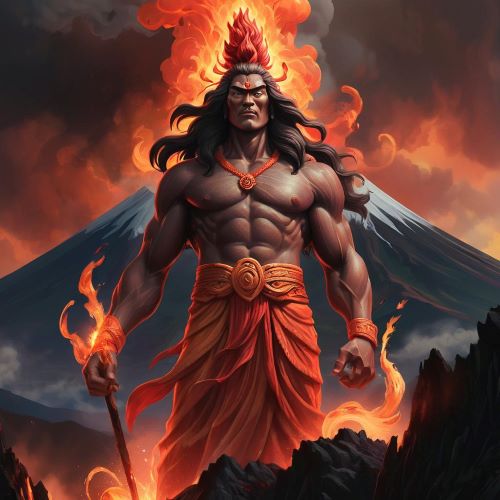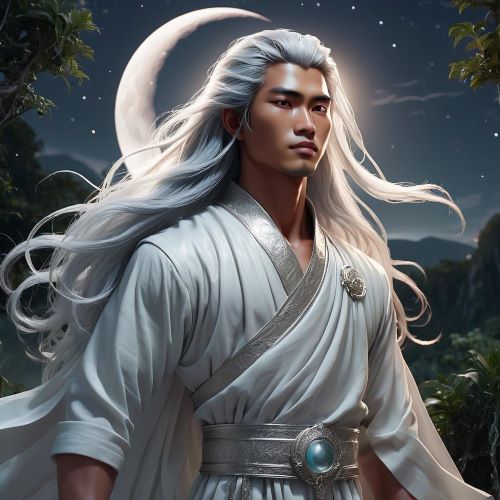Agui : God of Fire
Listen
At a glance
| Description | |
|---|---|
| Origin | Philippine Mythology |
| Classification | Gods |
| Family Members | Agwe (Brother) |
| Region | Philippines |
| Associated With | Fire, Volcanoes,Heat |
Agui
Introduction
Agui, a revered yet lesser-known deity in Philippine mythology, represents the primal force of fire. Rooted in the oral traditions of various Filipino ethnolinguistic groups—particularly among the Visayan and Tagalog peoples—Agui embodies both the destructive and regenerative aspects of his element. Unlike fire gods in other mythologies who are often associated with war or vengeance, Agui’s essence lies in balance. His power is not wielded to dominate, but to maintain the cosmic order alongside his elemental counterpart, Agwe, the god of water.
Through myth and oral lore, Agui served as a vital reminder of fire’s duality—capable of destruction, but also essential to life, warmth, and transformation. Despite being overshadowed in modern retellings by more prominent deities like Bathala or Maria Makiling, Agui’s legacy endures, reflecting indigenous Filipino cosmology and reverence for natural elements.
Physical Traits
While early records and oral stories rarely offer a concrete description of Agui’s form, folkloric interpretations help build a visual profile. Agui is typically envisioned as a radiant, imposing figure wreathed in fire. His skin is likened to glowing embers, emanating light and heat even in darkness. His hair flows like wild flames, constantly shifting in shape and hue, while his eyes burn with the intensity of molten lava.
These imagined features evoke awe and respect, underscoring Agui’s elemental power. Unlike deities with rigid forms, Agui’s physicality is fluid—like fire itself. His presence is said to command silence and reverence, much like the hush that falls before a wildfire consumes a forest.
Family
Agui’s familial role within the mythological hierarchy is defined primarily through his bond with Agwe, the god of water. This sibling relationship is more than myth—it serves as a symbolic framework for understanding the interplay between two opposing yet complementary forces in nature. Agui governs heat, combustion, and transformation, while Agwe rules over fluidity, depth, and renewal.
Their father is sometimes referenced in regional myths as Ama, a supreme being credited with creating elemental forces. This divine parentage aligns Agui with other creator-linked figures and situates him within a broader pantheon responsible for maintaining cosmic equilibrium. Their dynamic is not one of rivalry but of mutual necessity, reflecting indigenous Filipino beliefs about harmony in nature.
Other names
Given the diversity of languages and dialects across the Philippines, Agui is known by several variations, especially in oral traditions passed down through generations. In some regions, he may be referred to as Agio, Aguio, or even Aguëo, particularly in Pangasinense folklore. These variants are phonetic adaptations shaped by local speech patterns and storytelling styles.
Importantly, these names are often used interchangeably, depending on the region and narrator. The diversity in nomenclature highlights the decentralized nature of Philippine mythology, where stories evolve across islands yet remain connected by shared archetypes and themes. This multiplicity of names emphasizes the adaptability of myth, where cultural memory preserves essence over uniformity.
Powers and Abilities
As the god of fire, Agui’s dominion extends over all aspects of flame—its warmth, intensity, and unpredictable nature. His control over heat and combustion allows him to both destroy and purify. In spiritual contexts, fire is a medium for offerings, transformation, and even soul-cleansing. Agui’s flames are believed to consume not just physical matter but also metaphysical impurities.
One of his symbolic roles is that of rebirth through destruction. Just as volcanic soil fosters new growth after an eruption, Agui’s power clears the old to make way for the new. He also represents illumination, as fire has long been associated with inner wisdom and divine insight. In pre-colonial rituals, invoking Agui could signify a desire for clarity, courage, or purification.
Unlike wrathful or combative gods, Agui does not wield fire for conquest. His power is elemental—neutral, constant, and essential. Whether his flames nurture or destroy depends on the intentions of those who call upon him.
Modern Day Influence
Though Agui’s name is not as widely circulated as other mythological figures, his influence lingers in cultural memory, art, and environmental discourse. In some Visayan and Mindanao communities, fire-themed rituals or dances—often held during agricultural festivals—may carry symbolic references to Agui, celebrating fire’s role in transformation and harvest cycles.
Contemporary artists and digital creators have begun to reimagine Agui, drawing on his elemental symbolism to create visual narratives for comics, games, and educational content. He is frequently illustrated as a majestic, ember-skinned deity surrounded by whirling flames—reclaiming space in Filipino popular culture.
In the classroom, references to Agui appear in educational materials exploring indigenous mythologies, reinforcing the importance of pre-Hispanic belief systems. Additionally, in modern environmental conversations, Agui’s archetype is sometimes invoked metaphorically. His fire serves as a warning about the destructive consequences of human negligence, particularly in relation to wildfires, deforestation, and climate change.
Even outside traditional mythology, the name “Agui” lives on. Filipino poet A.F. Agui, for instance, explores fire as a metaphor for emotion, creativity, and contradiction—extending the mythological associations of the name into literary spaces. This connection, though not direct, reflects how themes of combustion and rebirth still resonate in modern artistic expression.
Related Images
Source
Clark, J. (2016, February 6). Visayan Deities in Philippine Mythology. The Aswang Project. https://www.aswangproject.com/visayan-deities-in-philippine-mythology/
FilipiKnow. (2023, July 7). Philippine Mythology Gods and Goddesses: An Ultimate Guide. https://filipiknow.net/philippine-mythology-gods-and-goddesses/
Studocu. (n.d.). Philippine Gods and Goddesses. https://www.studocu.com/ph/document/batanes-state-college/batchelor-of-elementary-education/gods-and-goddesses/105011920
Wikipedia contributors. (n.d.). List of Philippine mythological figures. Wikipedia. https://en.wikipedia.org/wiki/List_of_Philippine_mythological_figures
Frequently Asked Questions
What is lorem Ipsum?
I am text block. Click edit button to change this text. Lorem ipsum dolor sit amet, consectetur adipiscing elit. Ut elit tellus, luctus nec ullamcorper mattis, pulvinar dapibus leo.
What is lorem Ipsum?
I am text block. Click edit button to change this text. Lorem ipsum dolor sit amet, consectetur adipiscing elit. Ut elit tellus, luctus nec ullamcorper mattis, pulvinar dapibus leo.
What is lorem Ipsum?
I am text block. Click edit button to change this text. Lorem ipsum dolor sit amet, consectetur adipiscing elit. Ut elit tellus, luctus nec ullamcorper mattis, pulvinar dapibus leo.
What is lorem Ipsum?
I am text block. Click edit button to change this text. Lorem ipsum dolor sit amet, consectetur adipiscing elit. Ut elit tellus, luctus nec ullamcorper mattis, pulvinar dapibus leo.
What is lorem Ipsum?
I am text block. Click edit button to change this text. Lorem ipsum dolor sit amet, consectetur adipiscing elit. Ut elit tellus, luctus nec ullamcorper mattis, pulvinar dapibus leo.

